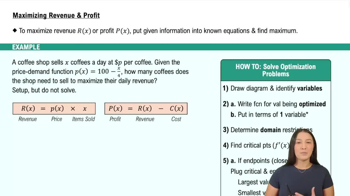Table of contents
- 0. Functions7h 52m
- Introduction to Functions16m
- Piecewise Functions10m
- Properties of Functions9m
- Common Functions1h 8m
- Transformations5m
- Combining Functions27m
- Exponent rules32m
- Exponential Functions28m
- Logarithmic Functions24m
- Properties of Logarithms34m
- Exponential & Logarithmic Equations35m
- Introduction to Trigonometric Functions38m
- Graphs of Trigonometric Functions44m
- Trigonometric Identities47m
- Inverse Trigonometric Functions48m
- 1. Limits and Continuity2h 2m
- 2. Intro to Derivatives1h 33m
- 3. Techniques of Differentiation3h 18m
- 4. Applications of Derivatives2h 38m
- 5. Graphical Applications of Derivatives6h 2m
- 6. Derivatives of Inverse, Exponential, & Logarithmic Functions2h 37m
- 7. Antiderivatives & Indefinite Integrals1h 26m
- 8. Definite Integrals4h 44m
- 9. Graphical Applications of Integrals2h 27m
- 10. Physics Applications of Integrals 2h 22m
5. Graphical Applications of Derivatives
Applied Optimization
Problem 4.5.17
Textbook Question
Rectangles beneath a semicircle A rectangle is constructed with its base on the diameter of a semicircle with radius 5 and its two other vertices on the semicircle. What are the dimensions of the rectangle with maximum area?
 Verified step by step guidance
Verified step by step guidance1
Consider the semicircle with radius 5 centered at the origin on the coordinate plane. The equation of the semicircle is given by \( y = \sqrt{25 - x^2} \).
Let the base of the rectangle be along the x-axis, with vertices at \((-x, 0)\) and \((x, 0)\). The other two vertices will be \((-x, \sqrt{25 - x^2})\) and \((x, \sqrt{25 - x^2})\).
The width of the rectangle is \(2x\) and the height is \(\sqrt{25 - x^2}\). Therefore, the area \(A\) of the rectangle can be expressed as \(A = 2x \cdot \sqrt{25 - x^2}\).
To find the maximum area, we need to differentiate the area function \(A(x) = 2x \cdot \sqrt{25 - x^2}\) with respect to \(x\) and set the derivative equal to zero to find critical points.
Solve the equation \(\frac{dA}{dx} = 0\) to find the value of \(x\) that maximizes the area. Then, substitute this value back into the expressions for the width and height to find the dimensions of the rectangle.
 Verified video answer for a similar problem:
Verified video answer for a similar problem:This video solution was recommended by our tutors as helpful for the problem above
Video duration:
11mPlay a video:
Was this helpful?
Key Concepts
Here are the essential concepts you must grasp in order to answer the question correctly.
Optimization
Optimization in calculus involves finding the maximum or minimum values of a function. In this problem, we need to determine the dimensions of the rectangle that maximize its area, which requires setting up a function for the area in terms of the rectangle's dimensions and then using techniques such as differentiation to find critical points.
Recommended video:

Intro to Applied Optimization: Maximizing Area
Area of a Rectangle
The area of a rectangle is calculated by multiplying its length by its width. In this context, the rectangle's dimensions are constrained by the semicircle, so we express the area as a function of one variable, typically the width, and derive the corresponding height using the semicircle's equation.
Recommended video:

Estimating the Area Under a Curve Using Left Endpoints
Semicircle Equation
The equation of a semicircle can be expressed as y = √(r² - x²), where r is the radius. For a semicircle with a radius of 5, the equation becomes y = √(25 - x²). This relationship is crucial for determining the height of the rectangle based on its base's position along the diameter, allowing us to express the area function accurately.
Recommended video:

Solving Logarithmic Equations

 1:13m
1:13mWatch next
Master Intro to Applied Optimization: Maximizing Area with a bite sized video explanation from Callie
Start learningRelated Videos
Related Practice








